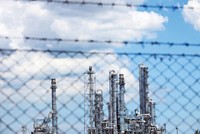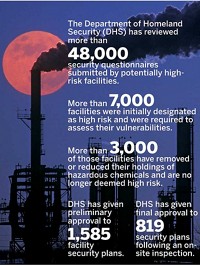Advertisement
Grab your lab coat. Let's get started
Welcome!
Welcome!
Create an account below to get 6 C&EN articles per month, receive newsletters and more - all free.
It seems this is your first time logging in online. Please enter the following information to continue.
As an ACS member you automatically get access to this site. All we need is few more details to create your reading experience.
Not you? Sign in with a different account.
Not you? Sign in with a different account.
ERROR 1
ERROR 1
ERROR 2
ERROR 2
ERROR 2
ERROR 2
ERROR 2
Password and Confirm password must match.
If you have an ACS member number, please enter it here so we can link this account to your membership. (optional)
ERROR 2
ACS values your privacy. By submitting your information, you are gaining access to C&EN and subscribing to our weekly newsletter. We use the information you provide to make your reading experience better, and we will never sell your data to third party members.
Safety
Homeland Security: Debate Over Chemical Plant Regulations Remains
by Glenn Hess
January 24, 2012
| A version of this story appeared in
Volume 90, Issue 4
Chemical manufacturers will continue to lobby for permanent authorization of the Chemical Facility Anti-Terrorism Standards (CFATS), the federal chemical plant-site security program. Under the nearly five-year-old initiative, the Department of Homeland Security (DHS) requires more than 4,700 high-risk facilities to conduct vulnerability assessments, develop site security plans, and implement protective measures to meet DHS-defined risk-based performance standards.
CFATS is currently authorized as an add-on to a DHS funding bill, and the chemical industry has been urging Congress to pass a long-term authorization of the program, which it strongly supports. Because CFATS is tied to the annual appropriations process, it is currently funded through September. Several pieces of legislation pending in Congress—H.R. 901, H.R. 908, and S. 473—would extend authorization of the existing chemical facility standards for three to seven years.
“We were very pleased when committees in both the House and Senate passed proposals last year to reauthorize CFATS,” says Calvin M. Dooley, president and CEO of the American Chemistry Council, which lobbies on behalf of the nation’s largest chemical companies. “This was one of the few issues where we saw bipartisan support, which gave us hope that legislation would be acted upon before the end of the year. Unfortunately, it didn’t get across the finish line in the first session, but we’re hopeful that we will see congressional action this year,” Dooley says. “At the minimum,” he adds, “we’re pleased that there has been bipartisan support for a one-year reauthorization of the CFATS program as part of the appropriations process.”
On the other side of the debate, environmental activist group Greenpeace and other members of an environmental-labor coalition will continue to urge Congress to pass legislation that gives DHS the power to order the highest risk facilities to adopt so-called inherently safer technology (IST), such as switching to safer processes or using less toxic substances. In November 2009, the then-Democrat-controlled House passed such a bill (H.R. 2868), but the measure died in the Senate.
With Congress bitterly divided and the chemical industry adamantly opposed to any legislation that mandates facilities’ use of IST, reform of the CFATS program or even long-term authorization will most likely have to wait until 2013.
“A bill with IST provisions is extremely unlikely to make it through a Republican House,” points out a Senate homeland security committee staff member. “And a bill without it is tough to get through a Democratic Senate.”
CFATS authorization many not be going anywhere this year, but an investigation of problems within DHS’s Infrastructure Security Compliance Division (ISCD), the office that oversees CFATS, may be. Sen. Susan M. Collins of Maine, the top Republican on the Senate Homeland Security & Governmental Affairs Committee, says an internal DHS assessment has found that “serious management problems, wasteful spending, insufficient and untrained personnel, and union demands are hindering the department’s implementation” of CFATS (C&EN, Jan. 9, page 6).
The internal report hasn’t been publicly released, but members of Congress have been briefed on its contents.
The assessment, Collins says, also notes that the lack of a longer term authorization by Congress has had a negative impact on the program. In 2006, Congress gave DHS limited authority to create a chemical facility security program. However, lawmakers have been unable to reach consensus on how to structure CFATS and make it a permanent part of DHS.
Collins notes that Rand Beers, the head of DHS’s National Protection & Programs Directorate, has vowed to fix the management, personnel, and other problems identified in the report. Signaling that oversight hearings will be held, Collins says Congress “will play a critical role in holding DHS accountable and ensuring the program is advancing our shared goal of securing America’s chemical facilities against terrorism.”
Any changes to CFATS should focus on the challenges at DHS that have slowed the pace of implementation, says William E. Allmond IV, vice president of government relations at the Society of Chemical Manufacturers & Affiliates, a trade group representing mostly small and midsized chemical companies. “CFATS is a fundamentally sound security policy that needs better administration by the department,” he says.
But Rick Hind, legislative director of Greenpeace’s toxics campaign, says many of the program’s failures stem from “the vague, contradictory, and loophole-ridden language in the 740-word CFATS statute.” DHS, he notes, lacks the authority to require a facility to implement any specific security process or tool.
“Right now, DHS is hamstrung in what they can require. As a result, they have been reduced to the role of pleading and cajoling industry to cooperate, with little legal authority to make things happen,” Hind says.







Join the conversation
Contact the reporter
Submit a Letter to the Editor for publication
Engage with us on Twitter